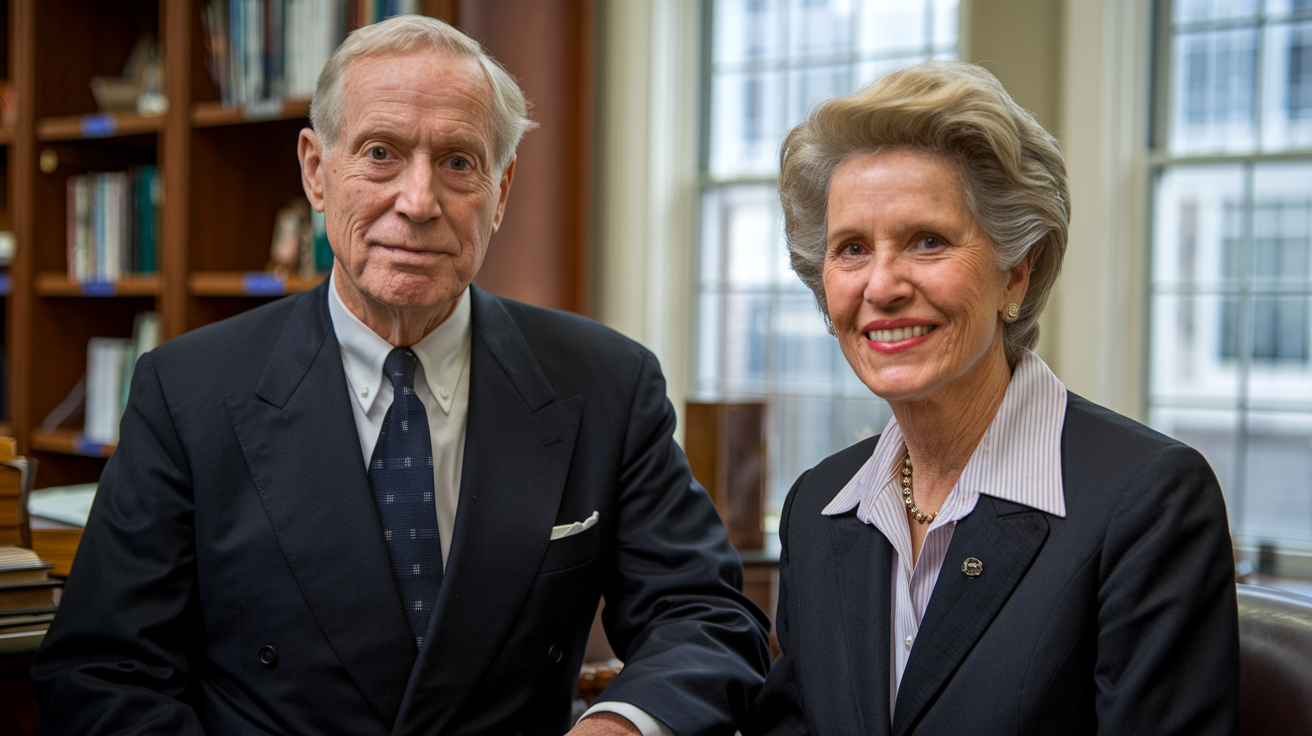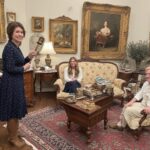Introduction:
While people name outstanding personalities who influenced the history of America, one cannot omit to mention J. Edgar Hoover, who played a significant role in the history of American law enforcement. He joined the Bureau as its Director in 1924, a position he would hold till his death in 1972, serving for 48 years. His effective leadership made deep and lasting changes in modern law enforcement practices, and again, it was not only the applied policies. His private life at that time, particularly his appearance, started to play a significant role in his persona. Among what captured viewers’ attention was the clothes HE wore; his office suits are symbols of his dominance. However, there is another influential individual whose wardrobe impacted the criminal justice system: Ann Burgess, the queen of criminal profiling, it can be concluded. This article will discuss the Mastermind Ann Burgess J. Edgar Hoover Outfit in Office and the personal branding of two icons in different fields.
J. Edgar Hoover’s Iconic Office Outfits: Making Power Through Dressing:
While J. Edgar Hoover’s management was identified by his choices and organizational actions, his public persona was part of his professional construction. One aspect that helped present Hoover as an enormously authoritative figure was that the Mastermind Ann Burgess J. Edgar Hoover Outfit in Office. While Hoover was often photographed dressed in his office or relaxing, the classic dark suits he wore would define his public image. Never found indecently dressed or inappropriately dressed, Hoover was almost always dressed in dark suits, which was obviously in tandem with his drones and stern-mannered approach towards law enforcement. His outfits of choice were dark-colored suits, primarily black, navy blue, or dark charcoal; the suits were perfectly fitting and well-tailored, focusing on power.
These options of dark shades of colors also helped create Hoover’s image as an authoritative man. Thus, his somewhat dark shades of clothing spoke volumes regarding discipline, focus, and seriousness of purpose. This testosterone-driven mastermind Ann Burgess J. Edgar Hoover outfit in office was matched to some shirts and ties. Often, Hoover comported himself in a cleaned, shining white shirt that set trademark against the black suit. That is why these shirts were accompanied by ties of conservative patterns, proving this man’s formal, businesslike attitude. Some elements of his outfit contributed towards portraying this facade of power and efficiency to the viewers as the head of the FBI.
The Mastermind Ann Burgess J. Edgar Hoover Outfit in Office, was putting up a professional facade and actively taking over the Bureau in power. His dressing strategy made a connection between him and the commanding position he filled, and this extended to his clothes as well. Judge Hoover so mastered the representational code of congruence that every time he looked into his office, especially during meetings, his appearance remained a constant message of his unshaken authority.
Bow Ties and Pocket Squares: Hoover’s Signature Style:
In the best tradition of Mastermind Ann Burgess J. Edgar Hoover Outfit in Office, accessories were an essential part of the mastermind. Hoover was famous for bow ties, which he often wore while working. Whereas most of the politicians of his generation preferred regular neckties, Hoover had a penchant for black silk bow ties. This minor yet distinctive marking meant that Hoover could be socially different from his stiff and formal counterparts. Thus, the bow tie appeared to become part of Hoover’s outfit, which made him look more individual despite the strict and businesslike image.
Pocket square was another necessity for the Mastermind Ann Burgess J. Edgar Hoover Outfit in Office. This one was slightly smaller and fit perfectly inside the shell pocket of his suit jacket, thus adding to the neatness of the man. Haberman explains the simultaneous use of bow ties and pocket squares was a conscious decision to sustain an appearance of professionalism and order. These accessories showed a great concern for power displays where details of the office were well groomed to show that Hoover meant business, especially when he was in office.
Such minute concerns are typical aspects of the meticulous planning that Hoover employed for his entire image. Every stitch of the fed Ann Burgess J. Edgar Hoover in office, right from the bow tie and pocket square, made significant statements to perfect the image of a profound, invincible leader. Through this continuous performance, Hoover was able to cultivate the idea of himself as a key figure not only in advancing police authority but also in American society as a whole.
Headgear and Other Accessories as Parts of Hoover’s Image:
While that may not be worn in the photos, it was necessary in the Mastermind Ann Burgess J. Edgar Hoover Outfit in Office. Interests: Hoover was a man with a wide-brimmed fedora when out of doors or with a similar headgear. Such a fashion statement fit the mid-20th century trends, yet the very haircut appareled Hoover with the look of authority that the latter wanted. Wearing a fedora on top of his outfit made Hoover look like he was always on top of anything that went on. The reader should consider that Hoover used accessories not only as ornamentation – they had the purpose of supporting his persona and the selected law enforcement model.
Moreover, Hoover’s shining shoes and glasses complement the professionalism of his outfit. In every aspect of his public and neat dress, he warned his colleagues and especially the public that he was a man who took his job seriously. According to these fashions, Hoover created a persona of efficiency and order for the legendary Bureau associated with him to this day.
The master strategist Mastermind Ann Burgess J. Edgar Hoover Outfit in Office also contributed to his potential to demand attention and respect. His hats, shoes, and accessories added to this measured look. As he ascended to the position of the Bureau’s Director, Hoover’s suits and ties policed his status as an indispensable and inconsolable leader.
Hoover’s Office Setting: An Extension of His Persona
In the same manner that much of his public profile was created by the crime-busting Mastermind Ann Burgess J. Edgar Hoover Outfit in Office, so did the working environment. Hoover’s office room was as much about what he was as a leader as it was about the tidiness depicted. His well-organized writing table, free from papers, usually depicted neatness and work ethic. From a physical perspective, this stark and organized environment reflected Hoover’s managerial, clean-shaven attitude toward work. Pictures depicting Hoover in office with a formal tailored suit added to the fact that he had a significant influence in the office. Down to the clothes Hoover wore to the organization of his office, there was a focus on perceived power and efficiency.
In many respects, the orchestrator Mastermind Ann Burgess J. Edgar Hoover Outfit in Office fashion was a Hooverian organization. The ensemble chosen by Hoover communicated that he wanted the American population to know that he was a man of order who cared as much about structure, organization, and authority as the engineers of America. His image was built through the clothes he wore and the office environment, and it was such an image that made him a memorable policeman and an American icon. The Clothes he wore and his office environment were part and parcel of the weapons he employed to ensure that his authority was always noticed within the Bureau.
Ann Burgess: The Reigning Queen of Criminal Profiling and an Assessment of Her Influence on Policing
Whereas J. Edgar Hoover’s suits remained tightly wound, fixed into place, Ann Burgess’s more public contributions to criminology and law enforcement also delivered long-lasting impacts. A prolific author, some of her early works laid the foundation for the FBI’s so-called ‘Behavioral Analysis Unit,’ which continues even today. She played a crucial role in developing forensic psychology and criminal profiling for the FBI, teaching its agents about factors helpful in distinguishing between different types of serial or violent offenders.
Although less conspicuous than Hoover’s, Ann Burgess’s professional attire was significant in building her authoritative image as an expert. In matters of dress code, being a woman working in a line of work where women were scarce, her dress was always professional, and she had the look of someone who wanted the job more than anything. Confidence and competence emanated from Burgess in her outfit, making other competitors within the criminal justice community know that they need to watch and learn from her. The field of criminal profiling has not been left out as her experience working with the FBI, alongside her tough-syllabled personnel, has left an incredible impression in the field.
Just as the Mastermind Ann Burgess J. Edgar Hoover Outfit in Office came to represent Hoover’s upgrading stewardship, Burgess’s outfit represented professionalism and her trailblazing criminal profiling; this even enabled her to vigorously stake her claims THROUGH her wardrobe, pointing out how she was instrumental in shaping what this newly emerging modality of law enforcement was to look like.
Conclusion:
Lastly, the Mastermind Ann Burgess J. Edgar Hoover Outfit in Office makes a study on how attire can be influential to perception and leadership. Hoover and Burgess were not only careful about their appearance and neatness but also used their clothes to convey power and professionalism in their manner. Even though he quietly resigned the previous year, Hoover’s dark suits, bow ties, and accessories ensured he instantly became an iconic figure of power and authority. Burgess’s professional business wear made her a credible voice on criminal profiling. Both of these two individuals played a significant role in the history of American law enforcement, and what people wear or what they do defines the future of a nation. The brilliant strategist Mastermind Ann Burgess J. Edgar Hoover Outfit in Office will forever and a day remain a theme to their gains and remembrance.






